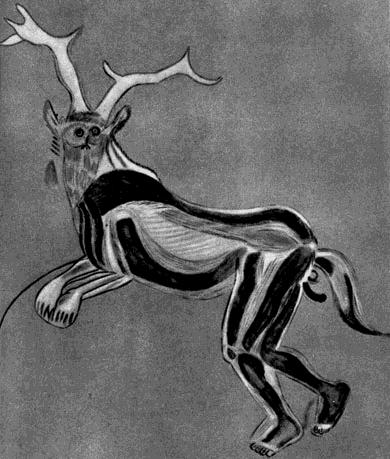The Sorcerer is one name for an enigmatic cave painting found in the cavern known as 'The Sanctuary' at the Cave of the Trois-Frères, Ariège, France, made around 13,000 BCE. The figure's significance is unknown, but it is usually interpreted as some kind of great spirit or master of animals. The unusual nature of The Sanctuary's decoration may also reflect the practice of magical ceremonies in the chamber. In his sketches of the cave art, Henri Breuil drew a horned humanoid torso and the publication of this drawing in the 1920s influenced many subsequent theories about the figure. However, Breuil's sketch has also come under criticism in recent years. A single prominent human figure is unusual in the cave paintings of the Upper Paleolithic, where the great majority of representations are o
| Attributes | Values |
|---|
| rdf:type
| |
| rdfs:label
| - Chamane des Trois-Frères (fr)
- Lo stregone (arte rupestre) (it)
- The Sorcerer (cave art) (en)
|
| rdfs:comment
| - Le chamane des Trois-Frères, aussi connu sous le nom de chamane dansant, est une figure pariétale dite « anthropozoomorphe » ou « thérianthrope », peinte dans la grotte ornée des Trois-Frères, l'une des trois grottes du Volp dans le département de l'Ariège, en région Occitanie, France. (fr)
- The Sorcerer is one name for an enigmatic cave painting found in the cavern known as 'The Sanctuary' at the Cave of the Trois-Frères, Ariège, France, made around 13,000 BCE. The figure's significance is unknown, but it is usually interpreted as some kind of great spirit or master of animals. The unusual nature of The Sanctuary's decoration may also reflect the practice of magical ceremonies in the chamber. In his sketches of the cave art, Henri Breuil drew a horned humanoid torso and the publication of this drawing in the 1920s influenced many subsequent theories about the figure. However, Breuil's sketch has also come under criticism in recent years. A single prominent human figure is unusual in the cave paintings of the Upper Paleolithic, where the great majority of representations are o (en)
- Lo Stregone è un dipinto rupestre trovato in una caverna conosciuta come "Il Santuario" a Trois-Frères, Ariège, in Francia. Sembra descrivere un uomo vestito come un cervo (o, alternativamente, un essere metà uomo, metà cervo). Il dipinto è datato circa al XIII millennio a.C. (it)
|
| geo:lat
| |
| geo:long
| |
| foaf:depiction
| |
| dcterms:subject
| |
| Wikipage page ID
| |
| Wikipage revision ID
| |
| Link from a Wikipage to another Wikipage
| |
| Link from a Wikipage to an external page
| |
| sameAs
| |
| dbp:wikiPageUsesTemplate
| |
| thumbnail
| |
| georss:point
| - 43.03111111111111 1.2083333333333333
|
| has abstract
| - Le chamane des Trois-Frères, aussi connu sous le nom de chamane dansant, est une figure pariétale dite « anthropozoomorphe » ou « thérianthrope », peinte dans la grotte ornée des Trois-Frères, l'une des trois grottes du Volp dans le département de l'Ariège, en région Occitanie, France. (fr)
- The Sorcerer is one name for an enigmatic cave painting found in the cavern known as 'The Sanctuary' at the Cave of the Trois-Frères, Ariège, France, made around 13,000 BCE. The figure's significance is unknown, but it is usually interpreted as some kind of great spirit or master of animals. The unusual nature of The Sanctuary's decoration may also reflect the practice of magical ceremonies in the chamber. In his sketches of the cave art, Henri Breuil drew a horned humanoid torso and the publication of this drawing in the 1920s influenced many subsequent theories about the figure. However, Breuil's sketch has also come under criticism in recent years. A single prominent human figure is unusual in the cave paintings of the Upper Paleolithic, where the great majority of representations are of animals. (en)
- Lo Stregone è un dipinto rupestre trovato in una caverna conosciuta come "Il Santuario" a Trois-Frères, Ariège, in Francia. Sembra descrivere un uomo vestito come un cervo (o, alternativamente, un essere metà uomo, metà cervo). Il dipinto è datato circa al XIII millennio a.C. Sia che rappresenti un dio, uno sciamano, un sacerdote o qualcos'altro, la figura danzante dello "Stregone" è un teriomorfo, una fusione simbolica di forme umane e animali che possono essere trovate in molte culture. I teriomorfi solitamente fondono assieme la forma umana con animali che sono direttamente importanti per la cultura locale, per esempio come cibo. Quindi l'immagine viene comunemente interpretata come uno sciamano che svolge un rituale propizio alla caccia; tuttavia questa interpretazione non può essere provata, né l'immagine si può direttamente collegare al successivo "Dio cornuto" delle regioni celtiche. Alcuni credono che si possono discernere altri animali all'interno dell'immagine: le mani sono state descritte come simili a quelle degli orsi e la faccia sia quella di un uccello . Quello su cui si è d'accordo è che le gambe e le braccia sono umane, come lo sono i genitali e vi sono dei parallelismi con altre antiche immagini nelle quali arti umani sono attaccati a un animale, solitamente un bisonte, per creare una figura bipede. (it)
|
| gold:hypernym
| |
| prov:wasDerivedFrom
| |
| page length (characters) of wiki page
| |
| foaf:isPrimaryTopicOf
| |
| geo:geometry
| - POINT(1.2083333730698 43.031112670898)
|
| is Link from a Wikipage to another Wikipage
of | |
| is Wikipage disambiguates
of | |
| is foaf:primaryTopic
of | |



![[RDF Data]](/fct/images/sw-rdf-blue.png)





![[cxml]](/fct/images/cxml_doc.png)
![[csv]](/fct/images/csv_doc.png)
![[text]](/fct/images/ntriples_doc.png)
![[turtle]](/fct/images/n3turtle_doc.png)
![[ld+json]](/fct/images/jsonld_doc.png)
![[rdf+json]](/fct/images/json_doc.png)
![[rdf+xml]](/fct/images/xml_doc.png)
![[atom+xml]](/fct/images/atom_doc.png)
![[html]](/fct/images/html_doc.png)